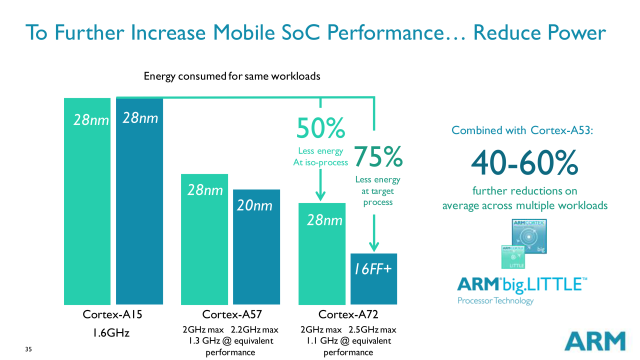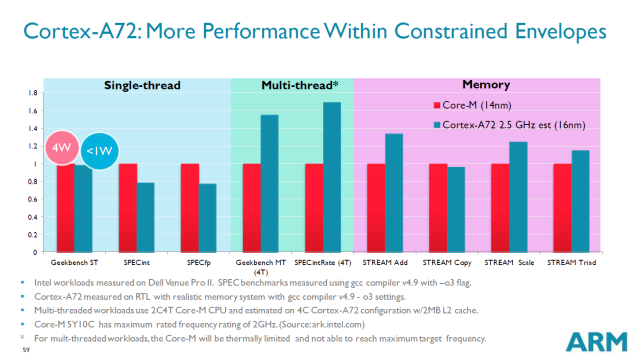
LONDON—At its annual, somewhat exclusive Tech Day event, ARM has detailed its new high-performance CPU core: Cortex A72. In simple terms, the A72 is a faster, more efficient, and smaller version of the Cortex A57. The first 16nm FinFET mobile SoCs with the Cortex A72 CPU will likely ship in 2016, fabricated by TSMC. In the words of Mike Filippo, ARM's chief architect for Cortex A72, "Our focus on A72 was to achieve next-gen performance and pull a ton of power out of the design. We did that in spades."
In more detailed terms, the Cortex A72 CPU pairs a three-wide, in-order front end with a five-wide, out-of-order back end (i.e. 8-issue). This is significantly wider than the A57, resulting in higher single-threaded performance. Along with the new architecture, ARM has "re-optimized every logical block from Cortex A57" to reduce power consumption and area (i.e. die size), which in turn reduces static power losses through leakage.

Drilling down into some of the more significant logical block changes: ARM says the A72 has a much better branch prediction, around 20 percent better than the A57. There's also a reworked 3-way L1 cache that's "almost as powerful as direct-mapped cache," and a much smaller (~10 percent) and reorganized dispatch unit.
When it comes to the functional units, ARM has made some huge latency gains across the board: FMUL, FADD, FMAC, and CVT have all had their cycle counts reduced significantly; the new 6-cycle FMAC (down from 9-cycle), according to ARM, is "state-of-the-art." The radix 16 and pipelined CRC integer units now have more bandwidth as well. Moving slightly away from the CPU core itself, the shared L2 cache (which in mobile devices will be shared with up to four A72 cores) has been "tuned for high bandwidth"—no exact figures were given, but ARM was pretty insistent that this is a key piece of the Cortex A72's performance gains.

While Cortex A72 is primarily targeted at next-gen process nodes (14 and 16nm), ARM also briefly touched upon the performance characteristics of Cortex A72 at 28nm. Both Qualcomm (Snapdragon 618, 620) and Mediatek (MT8173) are bringing 28nm Cortex A72 devices to market this year. The gains at 28nm are smaller but still significant.
In summary, Cortex A72 is a beast. Depending on the workload, ARM is claiming between 20 and 60 percent increase in IPC (instructions-per-clock) over Cortex A57. While the reduced latency on the functional blocks would usually make higher frequencies harder to hit, the smaller area and reduced power consumption mean that the A72 (2.7GHz) can actually clock about 10 percent higher than the A57 (2.5GHz). In terms of energy efficiency (i.e. performance per watt), ARM is reporting that A72 is between 18 and 30 percent better than A57.

Competitive with Broadwell? Really?
After letting us dwell on those rather astounding performance figures for a while, Filippo changed tack to address what I had found myself pondering: If Cortex A72 is that fast, how does it fare against Broadwell? According to ARM, very well indeed. The Broadwell CPU still trounces A72 when there's plenty of power on tap. But when you constrain the power and/or thermal envelope, as in the case of Core M, the Cortex A72 just about catches up.
Again, we should stress that these figures are directly from ARM—but in ARM's defense, it did seem like they'd tried quite hard to devise a fair and sane benchmark. Filippo was so confident in the methodology (and the A72) that he responded to our questions with this rather bold statement: "For the same performance, we are certainly sure that, running at full tilt, we're going to use 75 percent less power [than Broadwell]."
We'll hold off on further analysis until there's actually a shipping device with 16nm Cortex A72 inside, though—which, let's not forget, is probably the best part of a year away. There's also another conversation to be had about A72's applicability in servers—and indeed, ARM had some slides comparing A72 to Xeon—but again, let's wait for some shipping silicon.
-
Cortex A72 intro slideARM
-
Cortex A72 relative performanceARM
-
Cortex A72 relative power consumption, versus A15 and A57 at current- and next-gen process nodes.ARM
-
Cortex A72 IPC vs. Cortex A57ARM
-
Cortex A72 functional unitsARM
-
Cortex A72 block diagram, with some enhancements highlightedARM
-
Cortex A72 power consumption vs. Xeon E5 v3 (Haswell)ARM
-
Cortex A72 vs. Core M (Broadwell)ARM
O' caveats where art thou?
Now that you've seen all of ARM's undoubtedly optimistic internal figures, it's time to temper those statistics with a healthy dollop of realism. On paper, Cortex A72 certainly seems to tick all the boxes—it's smaller, faster, and more energy efficient. As ARM likes to point out, however, the company simply sells CPU designs to others. It remains to be seen what Samsung, Qualcomm, Mediatek, and dozens of other ARM licensees actually do with the A72 CPU core.
It's also important to remember that ARM isn't working in a vacuum. Qualcomm is expected to provide more details about its next-gen high-end CPU (Kryo) in the next couple of months, and we wouldn't be surprised if we see the first Kryo chip (the 14/16nm Snapdragon 820) ships around the same time as the first Cortex A72 chips. Meanwhile, Intel's Core M and Cherry Trail platforms are already in the market. By this time next year, we could be looking at the first Skylake and Willow Trail devices.
reader comments
113